
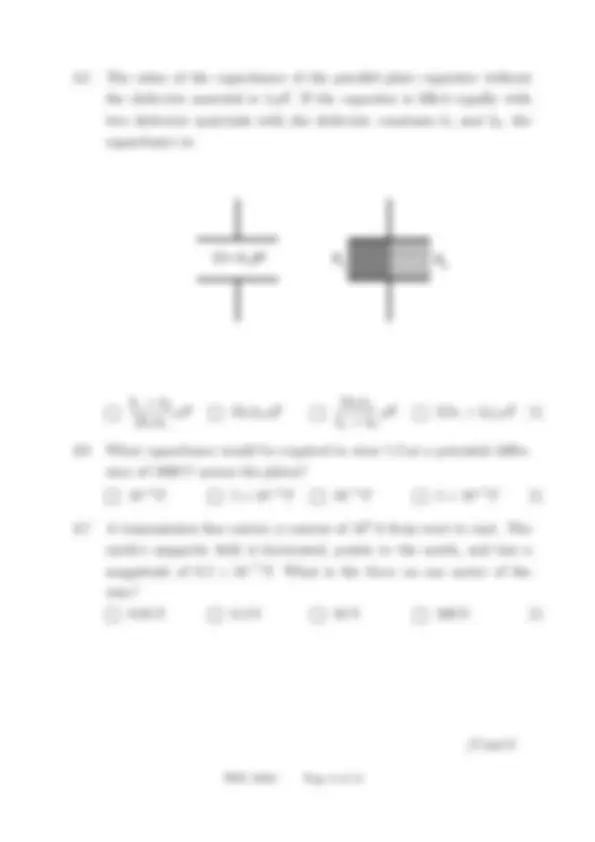
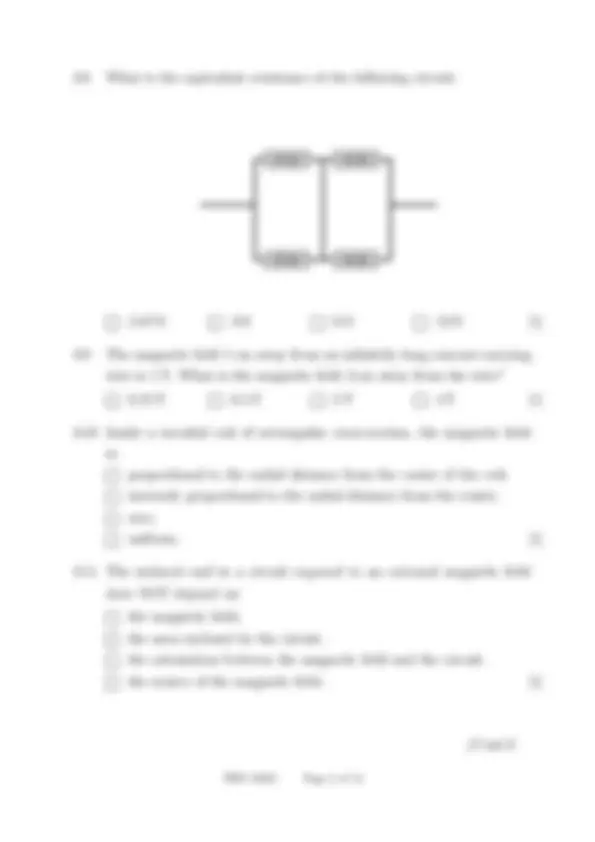
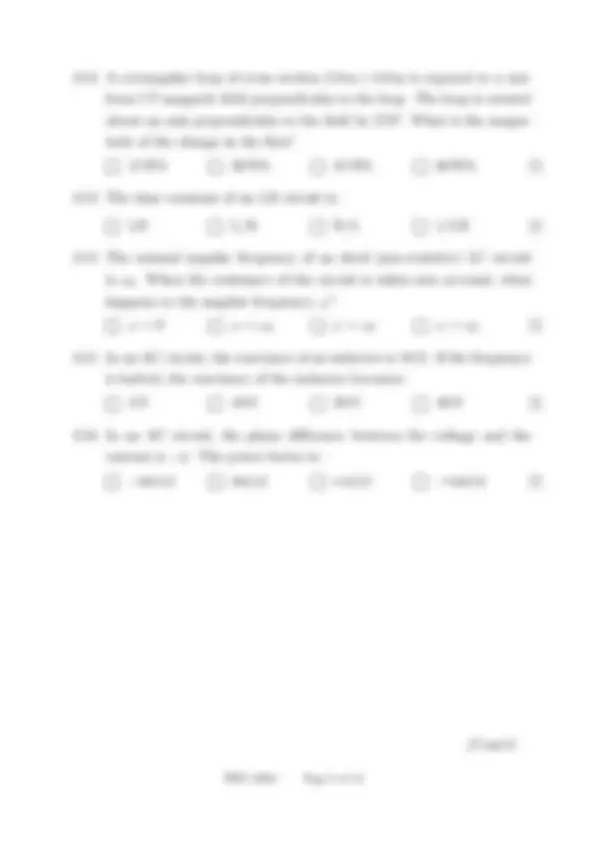
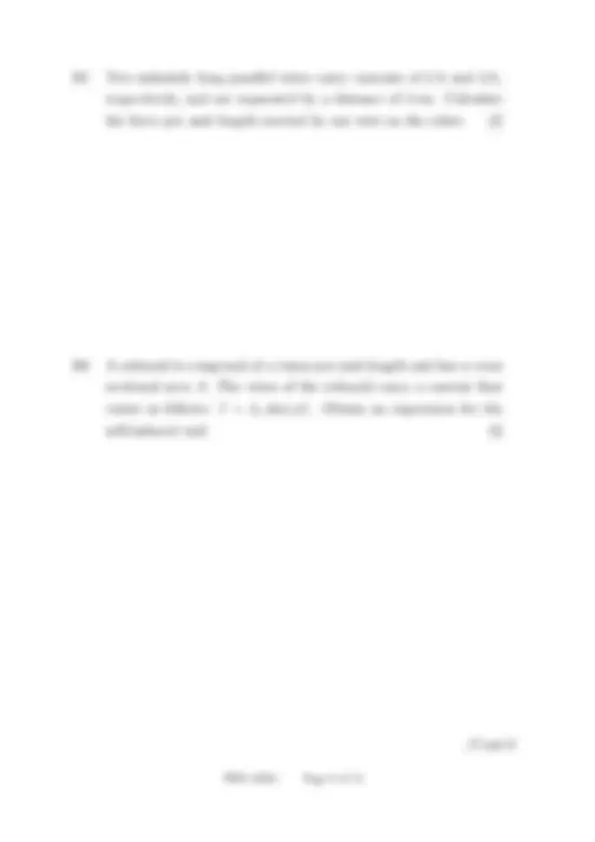
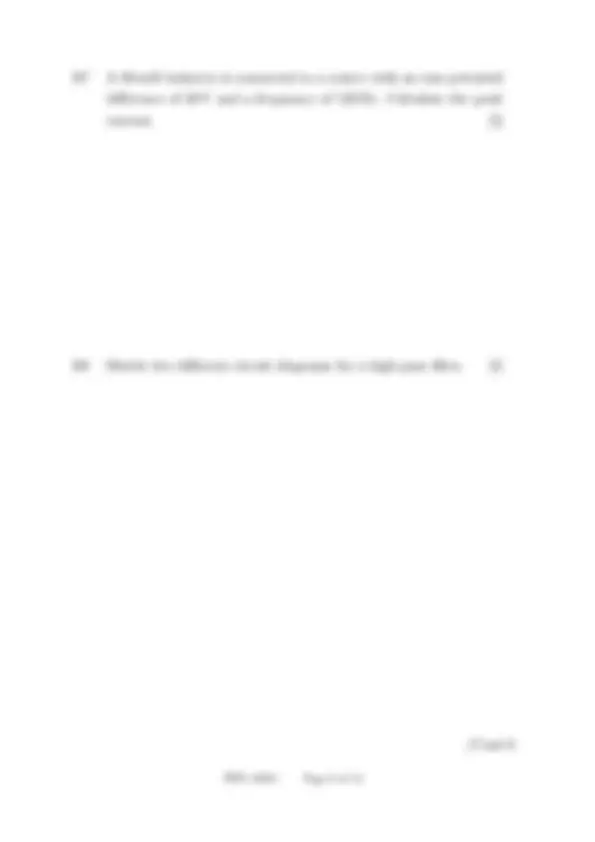
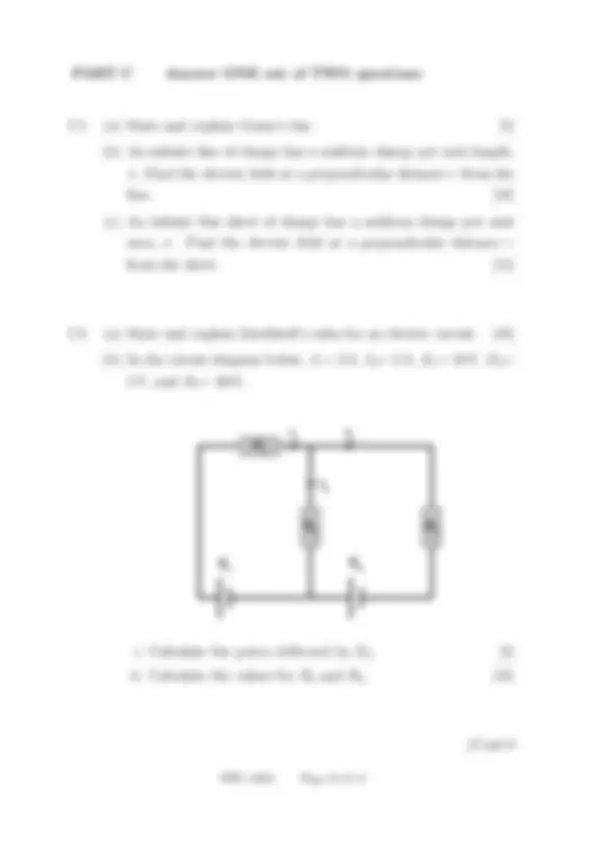


Study with the several resources on Docsity

Earn points by helping other students or get them with a premium plan


Prepare for your exams
Study with the several resources on Docsity

Earn points to download
Earn points by helping other students or get them with a premium plan
Community
Ask the community for help and clear up your study doubts
Discover the best universities in your country according to Docsity users
Free resources
Download our free guides on studying techniques, anxiety management strategies, and thesis advice from Docsity tutors
An old exam paper from keele university, 2010/11, for the physics/astrophysics course, specifically for the electricity and magnetism module (phy-10021). The exam covers various topics related to electricity and magnetism, including electrostatic forces, electric potential, capacitance, magnetic fields, and induced emf. Candidates are required to answer all questions in parts a and b, and one question each in parts c and d.
Typology: Exams
Uploaded on 09/29/2011
1 / 12

This page cannot be seen from the preview
Don't miss anything!







Please write your 8-digit student number here:
Level I
Monday 16th^ May 2011, 13.00-15.
PHYSICS/ASTROPHYSICS
PHY-
ELECTRICITY AND MAGNETISM
Candidates should attempt ALL of PARTS A and B, and ONE question from each of PARTS C and D. PARTS A and B should be answered on the exam paper; PARTS C and D should be answered in the examination booklet which should be attached to the exam paper at the end of the exam with a treasury tag. PART A yields 16% of the marks, PART B yields 24%, PART C yields 30%, PART D yields 30%.
Please do not write in the box below A C1 Total B C D D
NOT TO BE REMOVED FROM THE EXAMINATION HALL
PART A Tick one box by the answer you judge to be correct (marks are not deducted for incorrect answers)
A1 The electrostatic force between two point charges is 30 N. If the charge of both charges is tripled, then the force will be: 3.3 N 10 N 90 N 270 N [1]
A2 Which of the following graphs illustrate the variation of the electro- static field, E, with distance from a point charge.
a b c d [1]
A3 The electrostatic potentials at a point P due to charges Q 1 , Q 2 , and Q 3 are +40 V, −10 V and −20 V, respectively. What is the net elec- trostatic potential at point P? −70 V −10 V 10 V +70 V [1]
A4 What is the electrostatic potential across a distance of 5 m in a uniform electric field, E = 20 V/m. 4 V 20 V 25 V 100 V [1]
/Cont’d
A8 What is the equivalent resistance of the following circuit:
A9 The magnetic field 1 cm away from an infinitely long current-carrying wire is 1 T. What is the magnetic field 2 cm away from the wire? 0.25 T 0.5 T 2 T 4 T [1]
A10 Inside a toroidal coil of rectangular cross-section, the magnetic field is: proportional to the radial distance from the centre of the coil. inversely proportional to the radial distance from the centre. zero. uniform. [1]
A11 The induced emf in a circuit exposed to an external magnetic field does NOT depend on: the magnetic field. the area enclosed by the circuit. the orientation between the magnetic field and the circuit. the source of the magnetic field. [1]
/Cont’d
A12 A rectangular loop of cross section 2.0 m × 3.0 m is exposed to a uni- form 5 T magnetic field perpendicular to the loop. The loop is rotated about an axis perpendicular to the field by 270o. What is the magni- tude of the change in the flux? 15 Wb 30 Wb 45 Wb 60 Wb [1]
A13 The time constant of an LR circuit is:
LR L/R R/L 1/LR [1]
A14 The natural angular frequency of an ideal (non-resistive) LC circuit is ω 0. When the resistance of the circuit is taken into account, what happens to the angular frequency, ω? ω = 0 ω < ω 0 ω = ω 0 ω > ω 0 [1]
A15 In an AC circuit, the reactance of an inductor is 10 Ω. If the frequency is halved, the reactance of the inductor becomes: 5 Ω 10 Ω 20 Ω 40 Ω [1]
A16 In an AC circuit, the phase difference between the voltage and the current is −φ. The power factor is: −sin(φ) sin(φ) cos(φ) −tan(φ) [1]
/Cont’d
B3 Sketch the electric potential for a pair of charges −q and −2q separated by 10 cm. [3]
B4 Calculate the magnetic and electric forces and the ratio of the two forces for a particle of charge 3 nC moving at 5000 m/s in the presence of an electric field, E= 10^4 V/m and a magnetic field, B= 2 T (both B and E being perpendicular to the motion of the particle). [3]
/Cont’d
B5 Two infinitely long parallel wires carry currents of 2 A and 3 A, respectively, and are separated by a distance of 5 cm. Calculate the force per unit length exerted by one wire on the other. [3]
B6 A solenoid is composed of n turns per unit length and has a cross sectional area A. The wires of the solenoid carry a current that varies as follows: I = I 0 sin(ωt). Obtain an expression for the self-induced emf. [3]
/Cont’d
PART C Answer ONE out of TWO questions
C1 (a) State and explain Gauss’s law. [5]
(b) An infinite line of charge has a uniform charge per unit length, λ. Find the electric field at a perpendicular distance r from the line. [10] (c) An infinite flat sheet of charge has a uniform charge per unit area, σ. Find the electric field at a perpendicular distance r from the sheet. [15]
C2 (a) State and explain Kirchhoff’s rules for an electric circuit. [10]
(b) In the circuit diagram below, I 1 = 3 A, I 2 = 2 A, E 1 = 10 V, E 2 = 5 V, and R 1 = 20 Ω.
i. Calculate the power delivered by E 2. [2] ii. Calculate the values for R 2 and R 3. [18]
/Cont’d
PART D Answer ONE out of TWO questions
D1 (a) State and explain Amp`ere’s law. [5]
(b) A long straight wire and a rectangular loop lie in the same plane, as shown below. The dimensions and currents are indicated.
i. Determine the net magnetic force exerted on the loop by the wire. [10] ii. Determine the magnetic flux through the loop due to the wire. [10] iii. The current varies as I = (5t + 1) A, where t is the time in seconds. Calculate the induced emf across the loop. [5]
/Cont’d